German Water Protection Police Dagger by C. Eickhorn
CATEGORY: Version
SKU: 52.GOR.04.01.02.001.000
Estimated market value:
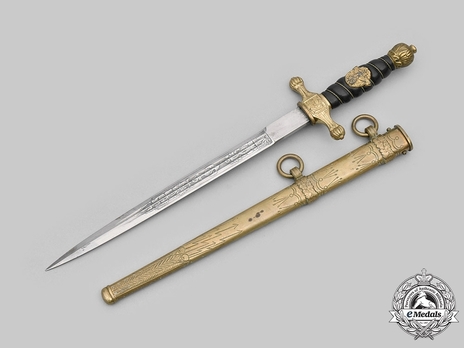
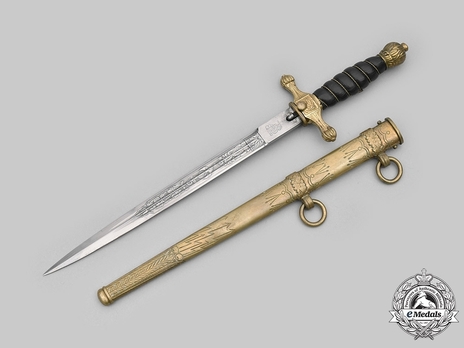
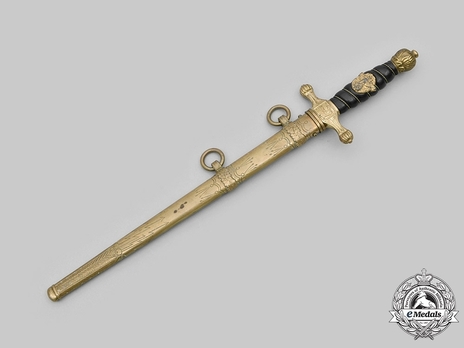
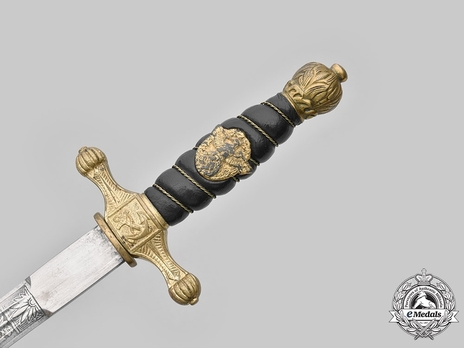
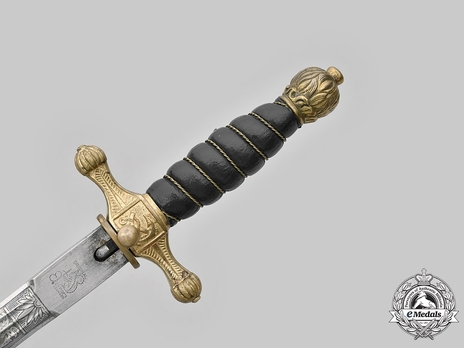
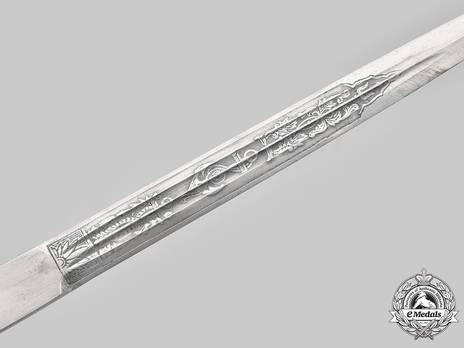
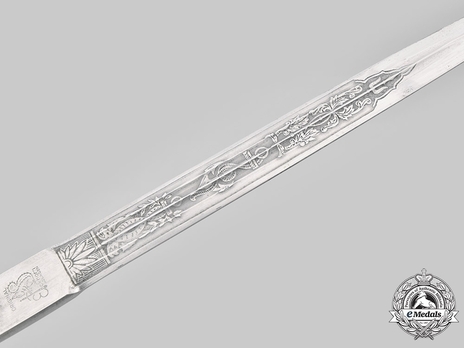
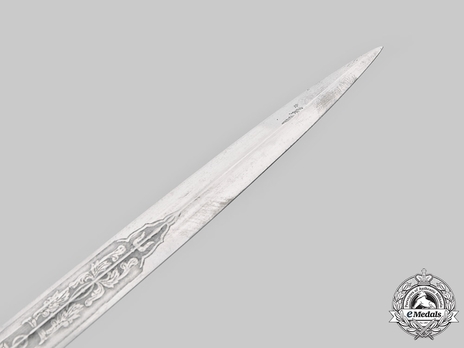
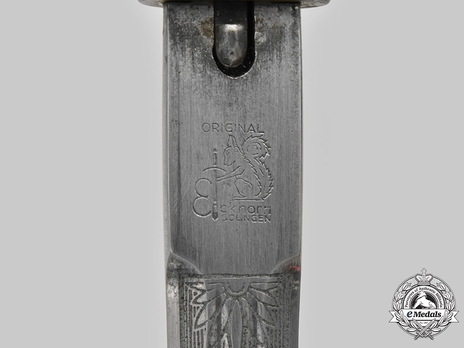
Estimated market value:
A rare and well-preserved Wasserschutzpolizei (Water Protection Police) officer’s dagger, measuring 400 mm in total length when inserted into the scabbard. It features a 250 mm-long magnetic steel blade with a sharpened tip and semi-sharpened edges, inset on both the obverse and reverse with dual fullers. Each side of the blade displays detailed acid-etched designs, consisting of central fouled anchors flanked by arabesque and serpentine imagery. Also etched onto the reverse ricasso is a maker’s mark of “ORIGINAL EICKHORN, SOLINGEN”, circumscribing the firm’s classic logo of a squirrel clutching a sword. The blade sits securely within a stylized gilded bronze alloy crossed, with a fouled anchor set into the centre of each side. The reverse of the cross guard has a functional push-button release connecting to a spring catch emanating from the reverse of the ricasso, securely locking the dagger into the scabbard during storage. A strip of ribbed dark blue leather comprises the handle grip, with the ribbing retaining an original twisted and rolled bronze alloy cord. Inset into the obverse of the handle is an Ordnungspolizei insignia consisting of a German national eagle clutching a wreathed mobile swastika, overlaying an oval oak leaf wreath. Constructed of gilded zink, the insignia measures 25 mm (w) x 25 mm (h). Completing the dagger is a rounded pommel nut, featuring raised, intricate floral designs. The dagger is accompanied by its period original scabbard, constructed of a bronze shaft with etched designs distributed across the circumference. Integrated into the upper third of the shaft are dual bands, presenting as raised oak leaves, each retaining a loop for the accommodation of a dagger hanger. The throat retains a functional catch, meeting the dagger’s clip, and is held together with dual side rivets. Minor issues consistent with age and use are evident, and include some pitting of the blade and loss of finish to the handle insignia. Otherwise fully intact, this rare dagger is in an overall near extremely fine condition.
During the Third Reich, an effort was made to unite all of Germany’s disparate provincial police forces and agencies into a single cohesive national unit. To attain this goal, Reichsführer-SS Heinrich Himmler was named Chief of the German Police in the Ministry of the Interior in June 1936. That same month, Himmler implemented new standardized uniforms, headgear, and insignia. The uniforms worn prior to Himmler’s appointment were often navy blue, particularly in what had been Prussia. The new uniforms were green, in a shade that was then dubbed “Police green”.
The German Police were divided into two main units, the Ordnungspolizei (Orps or Regular Police) and the Sicherheitspolizei (Secret Police); the Ordnungspolizei were unofficially called the green police (Grüne Polizei) as a result of their uniform colour. The Sicherheitspolizei were made up of two main organizations, the Gestapo and the Kriminalpolizei (Criminal Investigation Police). At the beginning of the Second World War, the Sicherheitspolizei were brought under the auspices of the Reich Main Security Office.
The Water Protection Police uniform was finalized, after several organizational and uniform iterations, on May 25, 1936. A dagger was introduced for wear by Water Protection Police Officers, Administrative Officers, and Officer Candidates within the Water Protection Police in 1937, but it was not officially established until 1938. Prior to the introduction of the dagger, the Navy Sabre was worn by Water Protection Police personnel. From 1938 onward, the Water Protection Police Dagger and Navy Sabre were both permitted for wear with the Water Protection Police service and dress uniforms. Since the dagger was not popular, it was abolished early into the Second World War.
The general design of the Water Protection Police Dagger mirrors the pre-1938 model of the Navy’s Officer’s dagger, except the grip, is composed of wood and a blue leather cover instead of white plastic.
The handle of the dagger is made up of the pommel, the grip, and the crossguard. The pommel and crossguard are composed of a gold-coloured (brass or alloy gilt) metal. The pommel has an ornate “flaming ball” shape. The grip is composed of wood with spiral indents and covered in a layer of blue leather with gold-coloured brass wire in the swirl indents. A gold-coloured police eagle insignia may or may not be located on the hilt obverse. The crossguard has two extending arms/quillons, and the obverse and reverse centre sections feature the image of a fouled anchor. The crossguard reverse also features the locking button mechanism, which obstructs the reverse fouled anchor image. A red felt washer may be located below the crossguard.
When present, the portepee is composed of gold-coloured bullion wire and the cord is gold-coloured with sections of blue thread.
The dagger has a double-fuller blade, and it is composed of steel plated with silver or nickel. The obverse and reverse blade surfaces are etched with naval designs. The obvese ricasso may be stamped with the manufacturer's logo, and the reverse ricasso should be stamped with a manufacturer mark, including name, location, and logo.
The scabbard is composed of gold-coloured metal (often brass gilt) and tends to feature a lightning bolt design with additional geometric and linear design elements. Every scabbard has two bands, one at the top of the scabbard neck and the other in the middle of the scabbard. The bands may have a “knotted rope” or oak leaf and acorn design. A suspension ring is attached to each band to facilitate the connection of dagger hangers.
The double strap dagger hangers are composed of a gold-coloured cover with blue stripes sewn onto dark blue velvet base and have gold-coloured (brass) buckles and fittings.

Comments
Sign in to comment and reply.


Scroll Top